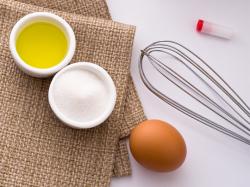Baking Expert Talks Egg Functionality
September 24, 2015 | 3 min to read

Park Ridge, Ill. – Is baking an art or a science? Like most fundamental questions, the answer is it's a combination of both. Before artistry can be achieved, the baker must follow basic scientific principles. Background knowledge of common ingredients is essential for success. In order to give bakers a more thorough understanding of egg ingredients, the American Egg Board (AEB) turned to the experts at AIB International in Manhattan, Kan., to film a short video series about eggs.
AIB’s primary goal is to “put science to work for the baker.” AEB tapped into that scientific knowledge by interviewing Luis Belozerco, Baking & Food Technical Services at AIB International. In the videos he details the unique functional properties egg ingredients contribute to baking systems.
Egg ingredients supply 20-plus functional benefits to food and beverage formulations overall. In most baking applications, more than one of the egg’s functional properties is at work. Eggs operate synergistically with other common ingredients during mixing, baking and shelf life. Belozerco describes how egg ingredients function within various baking systems. In addition, he dives into best practices to help maintain product appearance, taste, texture and quality.
“There is not a single substitute that can replace all of the functions eggs perform in all of the different types of baking products,” explained Belozerco. While bakers are always experimenting with new formulas, Belozerco said consumers judge the overall quality of a product by comparing a new or reformulated product with the original version. Therefore, it is important to maintain the flavor profile and sensory characteristics as close to the original as possible.
For example, macarons, meringues and foam-type cakes, such as angel food, depend on the foaming capability and aeration eggs provide for their appearance, volume and texture. Other products rely on eggs for a stable emulsion, particularly baked goods with a higher fat content. The more egg, the more stable the emulsion.
Some of the finer points Belozerco addresses in the video series include the three critical phases during baking production — the mixing process, oven temperatures and bake time.
Prior to joining the staff at AIB International, Luis Belozerco worked for more than 25 years as a baking professional on grain-based products and technical solutions for a number of multinational corporations. To view the video series about egg ingredients within baking, log onto http://www.aeb.org/food-manufacturers/videos/tech-talk-baking.
About AIB International
AIB International has offices strategically located across the globe and serves more than 120 countries, all with the same central mission: to empower the global food industry to elevate their food safety and production process capabilities. For more information about AIB International, visit www.aibonline.org or call 800-633-5137.
About REAL Egg ingredients
Available in liquid, frozen or dried forms, as whole eggs, yolks, whites or tailored to meet preparation or processing specifications, there’s a REAL Egg ingredient to suit any requirement. For more information about including REAL Eggs in product formulations or to find a supplier of REAL Egg ingredients, visit the American Egg Board’s website at www.aeb.org.
About the American Egg Board
The American Egg Board (AEB) is the U.S. egg producers’ communications link to food processors. AEB works to educate manufacturers and developers of new food products about the functionality and nutritional benefits of REAL Eggs. To assist food formulators, AEB develops resource materials and makes egg product experts available to answer technical questions. Visit www.aeb.org for more information, formulation tips and assistance and functional egg background.
Source: American Egg Board
